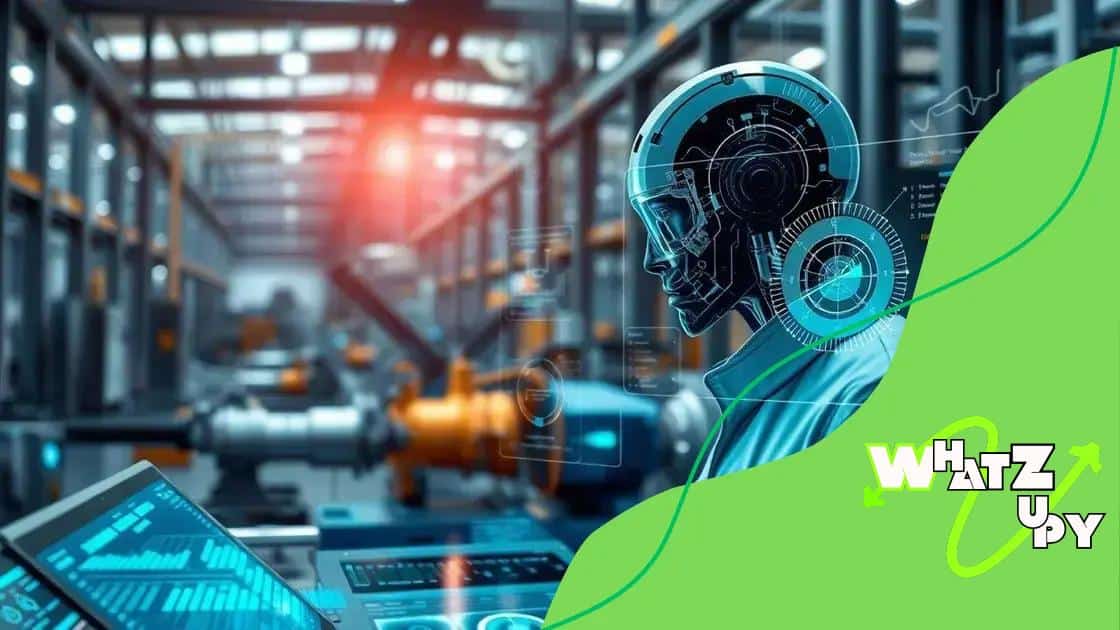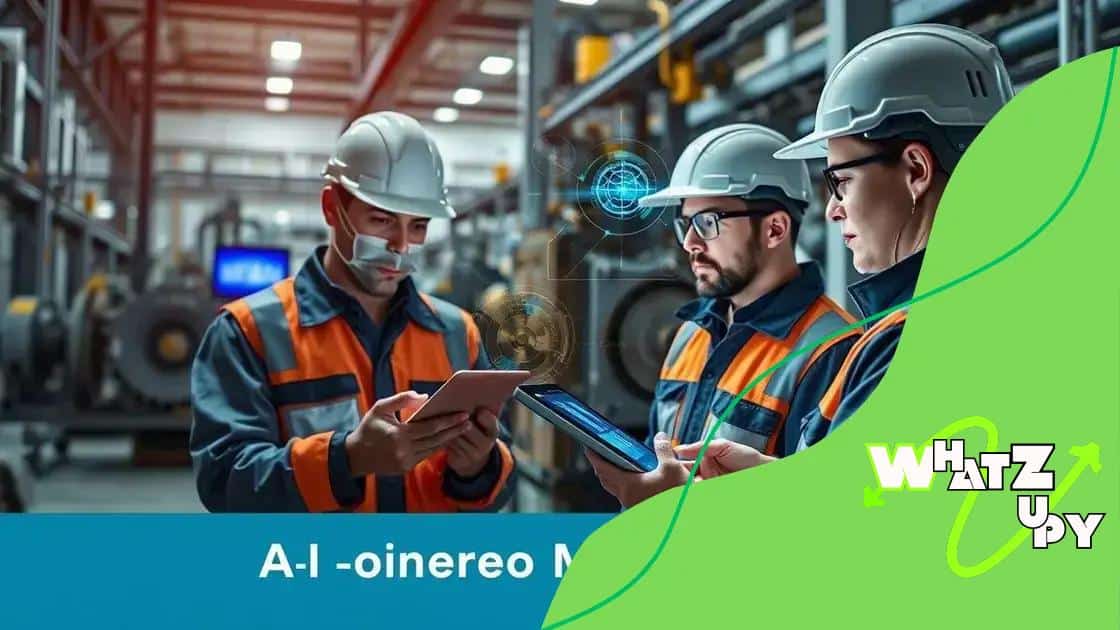How AI reshapes predictive maintenance in manufacturing

How AI reshapes predictive maintenance in manufacturing involves utilizing advanced technologies like AI and IoT to predict equipment failures, reduce downtime, decrease costs, and enhance operational efficiency.
How AI reshapes predictive maintenance in manufacturing is transforming the industry. Imagine reducing downtime and saving costs while utilizing advanced technologies.
Understanding predictive maintenance
Understanding predictive maintenance is crucial in modern manufacturing. It focuses on predicting when equipment will fail, allowing businesses to perform maintenance before issues arise. This proactive approach reduces equipment downtime and saves costs.
Predictive maintenance uses various technologies, including sensors and data analytics. By collecting data on equipment, companies can identify patterns and predict failures. This helps in planning maintenance schedules effectively.
Key Technologies in Predictive Maintenance
Several technologies contribute to efficient predictive maintenance:
- IoT Sensors: These devices collect real-time data from machines.
- Machine Learning: Algorithms analyze data to discover patterns.
- Cloud Computing: Stores and processes large amounts of data from various sources.
By employing these technologies, businesses can achieve higher efficiency and reliability in operations. However, understanding how to implement these systems can be complex.
Benefits of Predictive Maintenance
The advantages of predictive maintenance are significant:
- Reduced Downtime: Helps prevent unexpected breakdowns.
- Cost Savings: Lowers repair costs by addressing issues before they escalate.
- Improved Lifespan: Enhances the durability of machines through timely maintenance.
Investing in predictive maintenance not only optimizes resources but also enhances the overall productivity of manufacturing processes. Companies can maintain a competitive edge by utilizing data effectively. This approach isn’t just beneficial; it is becoming a necessity in a fast-paced industrial environment.
The role of AI in manufacturing
The role of AI in manufacturing is transforming the landscape of the industry. By integrating artificial intelligence, manufacturers can enhance productivity and efficiency significantly. This technology enables machines to learn from data, make decisions, and improve processes.
AI systems can analyze vast amounts of data faster than humans, allowing for more informed decision-making. For instance, AI can optimize production schedules and reduce waste by predicting machine failures before they occur. This proactive approach is invaluable in keeping operations smooth.
Applications of AI in Manufacturing
Companies employ AI in various ways to streamline operations:
- Quality Control: AI systems can detect defects in products at a speed and accuracy that human inspectors cannot match.
- Supply Chain Management: Machine learning algorithms enhance inventory management by predicting demand and automating restocking processes.
- Robotics: Advanced robots powered by AI can perform tasks that require precision and adapt to changes in production lines.
This integration of AI into manufacturing not only boosts efficiency but also fosters innovation. It allows for the development of smart factories that operate autonomously, reducing the need for human intervention.
Benefits of AI Implementation
The benefits of using AI in manufacturing are compelling:
- Operational Efficiency: AI optimizes workflows, leading to faster production times.
- Cost Reduction: By predicting failures, AI minimizes downtime, saving companies money.
- Enhanced Flexibility: AI systems can quickly adapt to changes in the manufacturing environment.
With these advancements, manufacturers can remain competitive and agile in a rapidly evolving market, embracing the future of production with confidence.
Benefits of AI-driven maintenance

Benefits of AI-driven maintenance are significant for manufacturers looking to enhance their operations. By integrating artificial intelligence into maintenance processes, companies can achieve remarkable improvements in efficiency and cost savings.
AI-driven maintenance utilizes data from machines to foresee potential failures. This predictive capability helps businesses minimize downtime and avoid costly repairs. Instead of reactive approaches, companies can schedule maintenance at optimal times based on predictive analytics.
Key Advantages of AI-Driven Maintenance
Several key benefits emerge from implementing AI in maintenance:
- Increased Equipment Lifespan: Regularly maintained equipment runs better and lasts longer.
- Cost Efficiency: Lower maintenance costs result from preventing unexpected breakdowns.
- Improved Safety: AI helps identify issues before they lead to accidents, creating a safer work environment.
Using AI algorithms, companies can analyze equipment performance over time. This helps uncover patterns that may indicate wear and tear, allowing for timely intervention. The effectiveness of AI in monitoring equipment can have a transformative impact on manufacturing productivity.
Real-World Applications
Industries are already seeing the benefits of AI-driven maintenance. For example, in automotive manufacturing, AI predicts when machine parts will fail, ensuring that replacements occur just in time, without halting production. In other sectors, such as energy, AI helps maintain equipment in critical infrastructure, prolonging asset life and ensuring reliability.
The positive effects of AI-driven maintenance extend beyond immediate savings. They promote a culture of continuous improvement within organizations. As companies adopt these advanced practices, they position themselves for future growth and sustainability, remaining competitive in a fast-evolving market.
Real-world examples of AI in action
Real-world examples of AI in action demonstrate how artificial intelligence is reshaping various industries, particularly manufacturing. Companies around the globe are successfully implementing AI to enhance efficiency and drive innovation.
One notable example is in the automotive industry. Leading manufacturers use AI to optimize production lines. By analyzing data from each machine, AI systems predict when equipment maintenance should occur. This proactive approach minimizes downtime and boosts overall productivity.
Examples in Different Industries
Several sectors are leveraging AI technology effectively:
- Electronics Manufacturing: Companies like Samsung use AI to streamline supply chains, ensuring materials are delivered just in time.
- Food Processing: Kraft Foods employs AI for quality control, detecting defects in products before they reach consumers.
- Aerospace: Boeing utilizes AI to monitor aircraft systems, predicting maintenance needs which enhance safety and reliability.
These examples highlight how diverse industries leverage AI for significant gains. Each application showcases AI’s ability to analyze complex data and provide actionable insights.
Impact on Business Operations
The impact of AI is profound. For instance, in pharmaceuticals, AI accelerates drug discovery processes. Analyzing vast datasets from clinical trials, AI can identify potential new drugs faster than traditional methods. This capability not only saves time but also reduces research costs.
Across the board, AI enhances decision-making and operational efficiency. As businesses adopt these technologies, they can adapt to market changes more quickly, improving their competitive edge. The ongoing evolution of AI in these applications indicates a bright future for industries willing to innovate and embrace new technologies.
Future trends in predictive maintenance
Future trends in predictive maintenance are evolving rapidly as technology advances. These trends will shape how industries manage their equipment and maintenance practices. Companies are increasingly adopting AI and IoT to enhance their predictive maintenance strategies.
One major trend is the integration of machine learning with predictive maintenance systems. This technology allows machines to learn from data and improve their forecasts over time. By analyzing historical data, machine learning algorithms can identify patterns that indicate when maintenance should occur.
Key Emerging Technologies
Several technologies are expected to play a crucial role in the future of predictive maintenance:
- Digital Twins: These are virtual replicas of physical systems. They enable real-time monitoring and analysis, predicting how machines will behave under different conditions.
- 5G Connectivity: Faster internet speeds will support real-time data transmission, allowing for more immediate analysis and quicker response times.
- Edge Computing: This technology processes data closer to the source, reducing latency and bandwidth use, allowing for quicker insights and actions.
As these technologies become more prevalent, industries can expect to see enormous benefits. For example, real-time data from equipment can enhance decision-making significantly, leading to optimized maintenance schedules.
Impact on Maintenance Strategies
With the rise of AI and machine learning, maintenance strategies will shift from reactive to proactive. Organizations will not just fix problems as they arise but will anticipate failures before they happen. This proactive approach will help reduce unexpected downtimes and costs.
Moreover, we will likely see an increase in the use of cloud-based systems for predictive maintenance. These platforms allow for easier data sharing and collaboration among teams, which can enhance overall maintenance efficiency. As the digital landscape continues to evolve, businesses must stay ahead of these trends to remain competitive.
FAQ – Frequently Asked Questions about Predictive Maintenance and AI
What is predictive maintenance?
Predictive maintenance is a proactive approach that uses data and analytics to predict when equipment will fail, allowing for timely maintenance.
How can AI improve predictive maintenance?
AI enhances predictive maintenance by analyzing large data sets to identify patterns, helping businesses predict failures before they occur.
What are the benefits of AI-driven maintenance?
AI-driven maintenance reduces downtime, lowers repair costs, increases equipment lifespan, and improves overall safety in the workplace.
What future trends should I be aware of in predictive maintenance?
Future trends include the use of digital twins, advanced machine learning algorithms, IoT integration, and enhanced connectivity through 5G.





